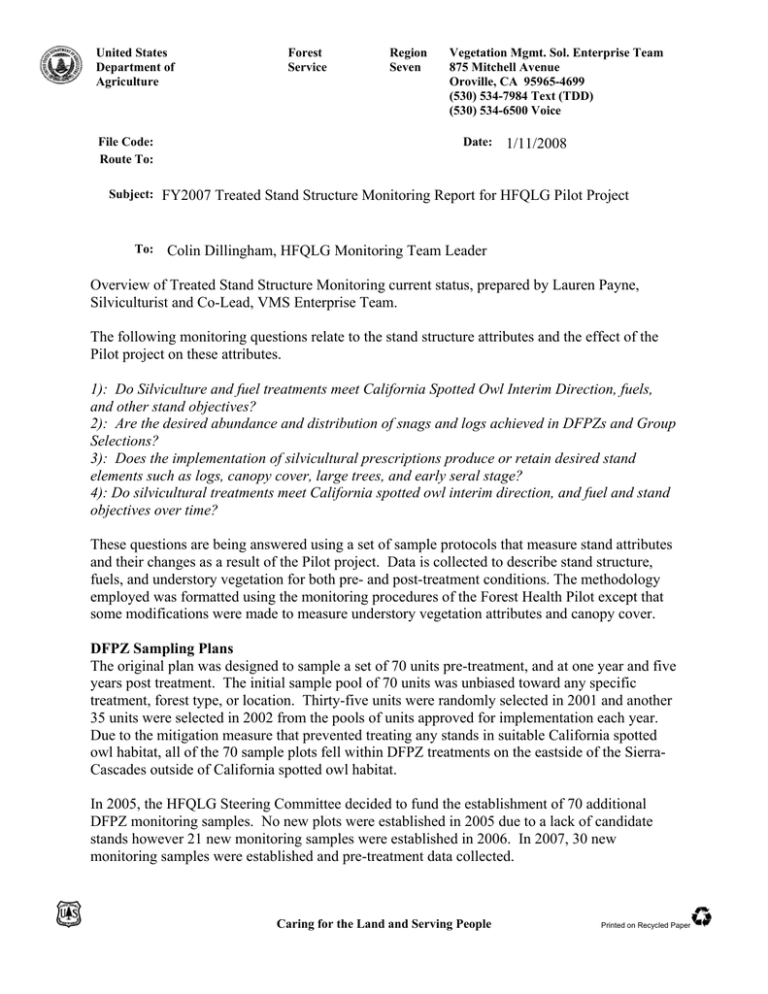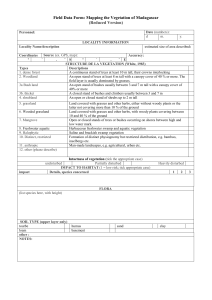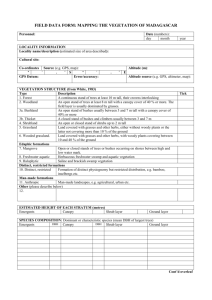United States Forest Region Vegetation Mgmt. Sol. Enterprise Team
advertisement

United States Department of Agriculture File Code: Route To: Forest Service Region Seven Vegetation Mgmt. Sol. Enterprise Team 875 Mitchell Avenue Oroville, CA 95965-4699 (530) 534-7984 Text (TDD) (530) 534-6500 Voice Date: 1/11/2008 Subject: FY2007 Treated Stand Structure Monitoring Report for HFQLG Pilot Project To: Colin Dillingham, HFQLG Monitoring Team Leader Overview of Treated Stand Structure Monitoring current status, prepared by Lauren Payne, Silviculturist and Co-Lead, VMS Enterprise Team. The following monitoring questions relate to the stand structure attributes and the effect of the Pilot project on these attributes. 1): Do Silviculture and fuel treatments meet California Spotted Owl Interim Direction, fuels, and other stand objectives? 2): Are the desired abundance and distribution of snags and logs achieved in DFPZs and Group Selections? 3): Does the implementation of silvicultural prescriptions produce or retain desired stand elements such as logs, canopy cover, large trees, and early seral stage? 4): Do silvicultural treatments meet California spotted owl interim direction, and fuel and stand objectives over time? These questions are being answered using a set of sample protocols that measure stand attributes and their changes as a result of the Pilot project. Data is collected to describe stand structure, fuels, and understory vegetation for both pre- and post-treatment conditions. The methodology employed was formatted using the monitoring procedures of the Forest Health Pilot except that some modifications were made to measure understory vegetation attributes and canopy cover. DFPZ Sampling Plans The original plan was designed to sample a set of 70 units pre-treatment, and at one year and five years post treatment. The initial sample pool of 70 units was unbiased toward any specific treatment, forest type, or location. Thirty-five units were randomly selected in 2001 and another 35 units were selected in 2002 from the pools of units approved for implementation each year. Due to the mitigation measure that prevented treating any stands in suitable California spotted owl habitat, all of the 70 sample plots fell within DFPZ treatments on the eastside of the SierraCascades outside of California spotted owl habitat. In 2005, the HFQLG Steering Committee decided to fund the establishment of 70 additional DFPZ monitoring samples. No new plots were established in 2005 due to a lack of candidate stands however 21 new monitoring samples were established in 2006. In 2007, 30 new monitoring samples were established and pre-treatment data collected. Caring for the Land and Serving People Printed on Recycled Paper United States Department of Agriculture Forest Service Region Seven Vegetation Mgmt. Sol. Enterprise Team 875 Mitchell Avenue Oroville, CA 95965-4699 (530) 534-7984 Text (TDD) (530) 534-6500 Voice To date, a total of 13 units have been sampled at one year post-treatment and 5 units have been sampled at five years post-treatment. The 2007 monitoring results marks the first year that treated units were ready for fifth year monitoring Group Selection Sampling Plans After approval of the Sierra Nevada Framework Project Amendment in 2004, HFQLG projects began to include Group Selection treatments. As a result, the HFQLG Steering Committee initially decided to fund the establishment of an additional set of 70 plots specifically to monitor group selection treatments. The HFQLG Steering Committee decided to increase the sample set for group selection treatments to a total of 140 plots in 2005. The same sampling strategy used for DFPZ monitoring is used to monitor the group selection treatments. Group selection units will be randomly selected at a rate of up to ten units per project until a total of 140 is reached. The data set for group selection treatments will be considered as a discrete sample pool. The results from the group selection monitoring will not be combined with the results of the DFPZ monitoring. To date, pre-treatment data has been collected on 47 group selection treatment units. Three of the group selection treatments have been monitored for one-year post-treatment monitoring through 2007. The forest stands being monitored in this sample set are not limited to the actual group selection units since the effects of treatment activities will extend beyond the boundary of each 0.5 to 2.0 acres unit. Potential changes to the stand structure of adjacent areas may result from construction of skid trails and landings to remove harvested trees; damage of adjacent trees from timber falling; and potential wind throw of trees along the edge of group selection units. Therefore, the stands where the plots are installed consist of an entire vegetation polygon from the PLAS vegetation map developed by VESTRA Resources containing the selected group selection units. In some instances a subdivision of a vegetation polygon may be selected. The criteria for selection of a subdivision of a vegetation polygon is based on other topographic (ridge / drainage) or cultural features (road / trail) that would limit the extent of the treatment activities to only a portion of a vegetation polygon. Plots are randomly located within the vegetation polygon and may or may not actually intersect the group selection unit. Results As more units become available for one-year and five-year post treatment monitoring, the need for a consistent methodical approach to evaluate treatments against the above listed monitoring questions as well as overall HFQLG pilot project objectives has become increasingly apparent. There is a high level of variability in vegetation types and stand conditions within the monitoring sample pool, as well as varying project-specific objectives. Often, post treatment monitoring results indicate some stand conditions meet treatment parameters whereas others do not. Taken individually, these measurements don’t fully determine whether overall treatment objectives have been met. VMS is currently working with research personnel in PSW as well as District and Forest specialists to develop a process of analysis to both provide a standard set of vegetation Caring for the Land and Serving People Printed on Recycled Paper United States Department of Agriculture Forest Service Region Seven Vegetation Mgmt. Sol. Enterprise Team 875 Mitchell Avenue Oroville, CA 95965-4699 (530) 534-7984 Text (TDD) (530) 534-6500 Voice and fuels measures as well as an evaluation of the effectiveness of treatments at meeting HFQLG and habitat objectives. We are using the 2007 monitoring results to help develop and test the analysis process. This process will allow us to evaluate treatment effectiveness and vegetation conditions at both the individual treatment unit and across the pilot project in a consistent manner. Overall, post treatment monitoring results in 2007 indicate little change in snags and generally less than a 10% reduction in canopy cover. Most of the units monitored in 2007 were near or below 50% canopy cover prior to treatment, and results indicate that most trees removed were smaller understory and midstory trees that didn’t appreciably add to overstory canopy cover. Large trees were preserved where they existed. There was a marked decrease in large down logs in Last Chance, Pittville and Red Clover units. Shrub cover was reduced in most units where it occurred, and remained appreciably below pre-treatment levels by year 5. Noxious weeds were detected in Last Chance, Pittville and Antelope Border units where none had been detected pretreatment. Treatment units Antelope Border 5 and 8 burned in the Antelope complex this summer prior to monitoring. Canopy cover dropped from roughly 50% to near 30% in these units and surface fuels including large down logs were largely reduced. Basal area in Unit 5 increased slightly whereas in Unit 8 it decreased slightly. The overstory in these treatment units appears to have survived relatively intact and indicates effectiveness of the DFPZ treatments. Conclusion The amount of post treatment data is still relatively sparse with only five DFPZ units monitored for fifth year post treatment, and first year monitoring still pending on most DFPZ units. Two additional group selection units were measured for post-first year monitoring in 2007. A total of 23 units have been monitored for either 1-year or 5-year post-treatment monitoring to date. The results to date indicate the retention of large trees, significant reduction of ladder fuels, reduction of down woody fuels to below maximum acceptable levels, and a loss of large down wood in some cases. Canopy cover is usually reduced by treatments, however canopy cover varies considerably, both pre and post treatment. While a few stands retained over 50% canopy cover after treatment, others dropped to well below 40% cover. Over one third of the units monitored to date showed no change to a slight increase in canopy cover one year after treatment. The ability to answer monitoring questions 1 through 4 remains limited as most of the units monitored to date fall outside of California Spotted Owl suitable habitat. Caring for the Land and Serving People Printed on Recycled Paper








